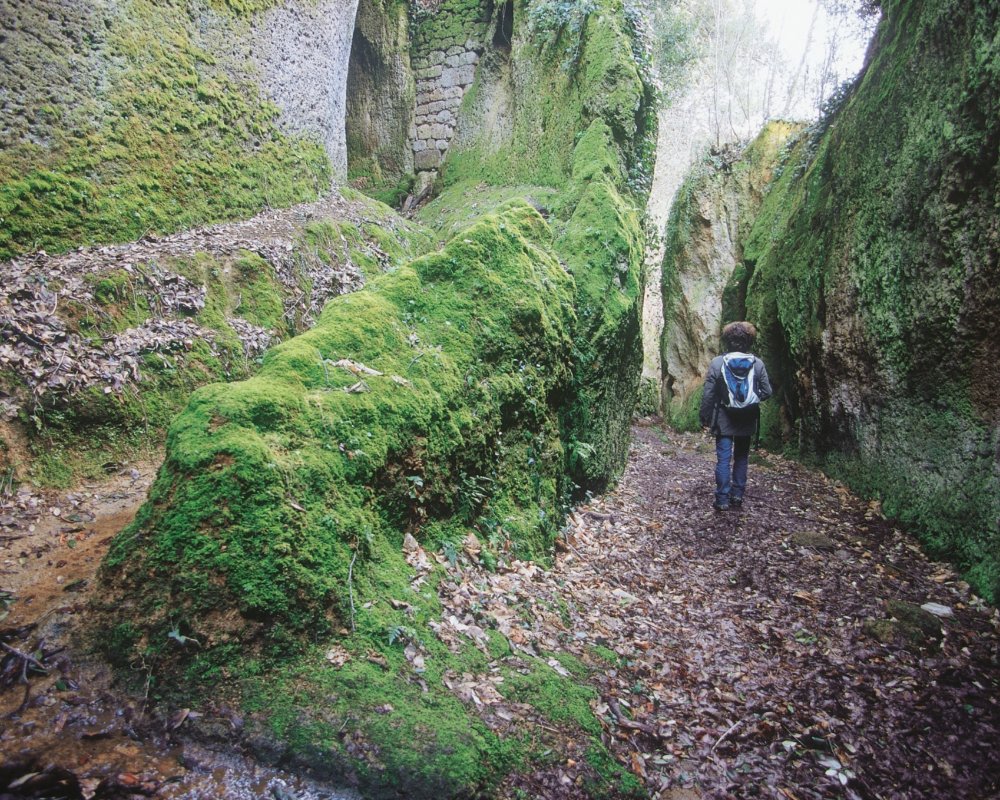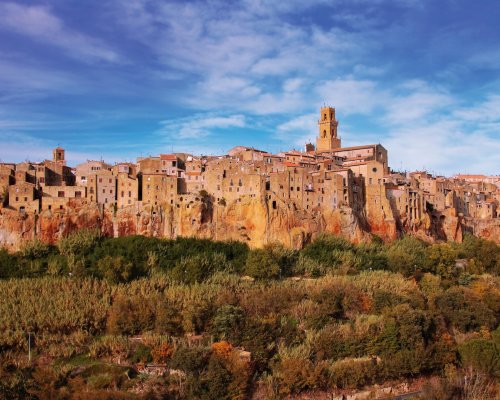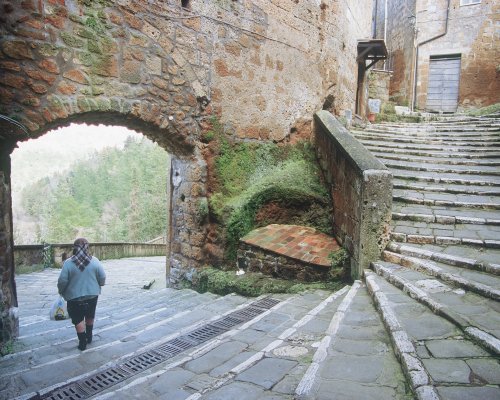Discovering the tuff civilizations
In the area around Pitigliano, a strong bond has existed between man and stone for thousands of years. Towns built on high plains of tuff, delicately placed on cliff sides overlooking the surrounding valleys, long underground paths carved into the rocks, hundreds of caves and burial sites. This is the scene that awaits visitors.
Two events shaped the unmistakable appearance of this territory. The first is connected to the volcanic activity in the area on the border between Tuscany and Lazio around 600,000 years ago: the eruptions formed the tuff rocks that characterize this place.
This particular area was also home to a second event with far-reaching effects, that is, the foundation around the 10th-9th centuries BCE, toward the end of the Bronze Age, of the Etruscan civilization, one of the most complex and mysterious ancient cultures.
It was the Etruscans who established the strict bond with this land, building their houses atop of the tuff cliffs. Within the tender heart of the lava rock, they dug out cities for the dead, necropolises that would mark their legacy for centuries, eternal places of memory and mystery. Just as mysterious are their “vie cave,” gigantic gashes cut through the tuff, some 20 or more metres deep, and whose original purpose remains unknown even today.
Our journey into the tuff civilization begins in Pitigliano, where the houses seem to be “born” directly from the rock, forming surreal structures.
Along the road that leads up to the plateau, characterized by hairpin turns, the view first meets the shapeless tuff, followed by the chaotic tangle of medieval houses and, finally, the large arches of the Medici-era aqueduct, made more out of air than material.
Before entering the labyrinth of alleyways, you will need to pass under the severe gaze of Palazzo Orsini, originally an Aldobrandesca fortress, perfectly placed to protect the only link between the town and the “mainland”: from the other sides, Pitigliano appears like a narrow peninsula, jutting out into an impregnable abyss.
Behind the palace, piazza della Repubblica cuts the “isthmus” of Pitigliano from north to south, offering a dual view of the ravine surrounding the town. A taste of the game of solids and voids awaits us in this maze of a village, where the narrow alleys winding through the houses suddenly transform into suspended terraces overlooking the cliffs.
The heart of the village is the narrow piazza Gregorio VII, where the cathedral dedicated to Saints Peter and Paul is located, along with its bell tower, whose massive and burly appearance betray its historic military use. Behind the cathedral, along via Zuccarelli, Pitigliano hides another one of its surprises: just slip into one of these dark alleys and you’ll find yourself in the Middle East.
This is Little Jerusalem, the ghetto that for several centuries, beginning in the 1500s, was home to one of the most flourishing Jewish communities in central Italy.
A visit to the synagogue is a must. Inside, you can admire the sacred Torah ark on the back wall, at the centre of which is the bema. The matroneum is located in the upper part and in the lower part, the ritual bath. Designated rooms carved into the rock are home to the kosher butcher, the oven for baking matzah, the kosher wine cellar and the dye-works.
Our walk through these streets ends at the steep staircase on via di Porta Sovana, which descends through into valley and the mystery of the Etruscan Vie Cave.
Our journey into the tuff civilization begins in Pitigliano, where the houses seem to be “born” directly from the rock, forming surreal structures.
Along the road that leads up to the plateau, characterized by hairpin turns, the view first meets the shapeless tuff, followed by the chaotic tangle of medieval houses and, finally, the large arches of the Medici-era aqueduct, made more out of air than material.
Before entering the labyrinth of alleyways, you will need to pass under the severe gaze of Palazzo Orsini, originally an Aldobrandesca fortress, perfectly placed to protect the only link between the town and the “mainland”: from the other sides, Pitigliano appears like a narrow peninsula, jutting out into an impregnable abyss.
Behind the palace, piazza della Repubblica cuts the “isthmus” of Pitigliano from north to south, offering a dual view of the ravine surrounding the town. A taste of the game of solids and voids awaits us in this maze of a village, where the narrow alleys winding through the houses suddenly transform into suspended terraces overlooking the cliffs.
The heart of the village is the narrow piazza Gregorio VII, where the cathedral dedicated to Saints Peter and Paul is located, along with its bell tower, whose massive and burly appearance betray its historic military use. Behind the cathedral, along via Zuccarelli, Pitigliano hides another one of its surprises: just slip into one of these dark alleys and you’ll find yourself in the Middle East.
This is Little Jerusalem, the ghetto that for several centuries, beginning in the 1500s, was home to one of the most flourishing Jewish communities in central Italy.
A visit to the synagogue is a must. Inside, you can admire the sacred Torah ark on the back wall, at the centre of which is the bema. The matroneum is located in the upper part and in the lower part, the ritual bath. Designated rooms carved into the rock are home to the kosher butcher, the oven for baking matzah, the kosher wine cellar and the dye-works.
Our walk through these streets ends at the steep staircase on via di Porta Sovana, which descends through into valley and the mystery of the Etruscan Vie Cave.
The Vie Cave are ancient and gigantic corridors carved into the tuff rock by the Etruscans, characteristic of the land surrounding Pitigliano, Sovana and Sorano. Historians still debate the original purpose of this road network. Where they a drainage system or an escape route during military attacks? Were they ancient communication routes or sacred paths taken by processions honouring Mother Earth and the dead?
Whatever they were once used for, adventuring into this labyrinth is a stupendous experience: the beauty of the scenery, their mysterious nature (they’re often hidden from view thanks to overhead vegetation) and the perception of the devotion that the Etruscans’ had for the land blend together, creating a sense of admiration that is almost moving.
The first taste of these environs can be found just outside Porta Sovana, where there are directions for the “Poggio Cane” via cava, the one closest to town. The road advances quickly, but you’ll nevertheless come across immensely interesting elements.
One you’ve reached the asphalt road, follow this for a short stretch until you arrive at the curve where there are directions (on the left) for the San Giuseppe via cava, the longest in the area and one of the most fascinating.
Venture between these deep walls as you tread along the rocky bottom of the road, where impressions have been made over time from carriages and the infinite crossings of man over the centuries. Along the route, you will also find Etruscan necropolises with typical chamber tombs and, a little further beyond, frescoed on a boulder, the image of Saint Joseph.
Continue until you reach the beautiful and ancient Olmo Fountain and, shortly thereafter, a small asphalt street that you’ll take toward the east.
Head straight on until you come to directions on the left for the Pian dei Conati via cava. Throughout the path, you’ll discover many traces of the crossings humans have made through these roads for thousands of years: basins, cup marks and the mysterious parallel grooves engraved by the tuff outcrops.
You’ve come to the end of the via cava, so now make your way down the main road to Sovana.
The Vie Cave are ancient and gigantic corridors carved into the tuff rock by the Etruscans, characteristic of the land surrounding Pitigliano, Sovana and Sorano. Historians still debate the original purpose of this road network. Where they a drainage system or an escape route during military attacks? Were they ancient communication routes or sacred paths taken by processions honouring Mother Earth and the dead?
Whatever they were once used for, adventuring into this labyrinth is a stupendous experience: the beauty of the scenery, their mysterious nature (they’re often hidden from view thanks to overhead vegetation) and the perception of the devotion that the Etruscans’ had for the land blend together, creating a sense of admiration that is almost moving.
The first taste of these environs can be found just outside Porta Sovana, where there are directions for the “Poggio Cane” via cava, the one closest to town. The road advances quickly, but you’ll nevertheless come across immensely interesting elements.
One you’ve reached the asphalt road, follow this for a short stretch until you arrive at the curve where there are directions (on the left) for the San Giuseppe via cava, the longest in the area and one of the most fascinating.
Venture between these deep walls as you tread along the rocky bottom of the road, where impressions have been made over time from carriages and the infinite crossings of man over the centuries. Along the route, you will also find Etruscan necropolises with typical chamber tombs and, a little further beyond, frescoed on a boulder, the image of Saint Joseph.
Continue until you reach the beautiful and ancient Olmo Fountain and, shortly thereafter, a small asphalt street that you’ll take toward the east.
Head straight on until you come to directions on the left for the Pian dei Conati via cava. Throughout the path, you’ll discover many traces of the crossings humans have made through these roads for thousands of years: basins, cup marks and the mysterious parallel grooves engraved by the tuff outcrops.
You’ve come to the end of the via cava, so now make your way down the main road to Sovana.
Just like Pitigliano, Sovana’s origins are deeply rooted in the tuff rock, where the Etruscans, and perhaps other civilizations in previous centuries, built their first homes.
Today, Sovana looks like a perfectly preserved medieval village. The ruins of the Aldobrandeschi Castle greet you as you enter the town, a sign of the power once held by the family that dominated this territory. According to tradition, Hildebrand of Sovana was born into the Aldobrandeschi family, later becoming Pope Gregory VII in the mid-11th century: the very man involved in the Investiture Controversy, the excommunication of Emperor Henry IV and the Humiliation of Canossa.
Climbing via del Pretorio, you’ll arrive in the namesake piazza, quintessential of the medieval spirit of the village. You are now standing before the elegant façade of the 13th-century Palazzo dell’Archivio (once the headquarters of the municipality), with its large clock and little bell-gable. To the left is the Church of Santa Maria.
On either side, in architectural continuity, are the palace of the Bourbon del Monte marquises and the early Christian Church of San Mamiliano, one of the oldest buildings in Sovana and today home to the museum dedicated to the saint and the “Sovana Treasure,” a collection of 498 gold coins from the 5th century CE that were found in 2004 during restorations to the building.
On the opposite side of the piazza, the façade of Palazzo Pretorio boasts a display of the coats of arms of the Captain of the People and the Sienese Commissioners that governed Sovana in the 15th and 16th centuries.
Moving beyond the piazza, walk along via di Mezzo until you arrive at the edge of town, where the Sovana Cathedral stands, one of the most important Romanesque-Gothic buildings in all of Tuscany. Having made it this far, it would seem that this walk through history has come to an end, but the tuff civilization still has many secrets to reveal.
And so, continue past the cathedral and head down toward the small village cemetery. Now walk for a few hundred metres along the asphalt road in the direction of San Martino sul Fiora to arrive at the Etruscan necropolis of Sopraripa. Here, among the many artefacts, you can admire the evocative tomb of the Sirena (it can probably be dated to between the 3rd and 2nd centuries BCE), located atop a rise and decorated with a large arched niche flanked by two demons keeping watch over the deceased and, on the pediment, the figure of a two-tailed siren.
Just like Pitigliano, Sovana’s origins are deeply rooted in the tuff rock, where the Etruscans, and perhaps other civilizations in previous centuries, built their first homes.
Today, Sovana looks like a perfectly preserved medieval village. The ruins of the Aldobrandeschi Castle greet you as you enter the town, a sign of the power once held by the family that dominated this territory. According to tradition, Hildebrand of Sovana was born into the Aldobrandeschi family, later becoming Pope Gregory VII in the mid-11th century: the very man involved in the Investiture Controversy, the excommunication of Emperor Henry IV and the Humiliation of Canossa.
Climbing via del Pretorio, you’ll arrive in the namesake piazza, quintessential of the medieval spirit of the village. You are now standing before the elegant façade of the 13th-century Palazzo dell’Archivio (once the headquarters of the municipality), with its large clock and little bell-gable. To the left is the Church of Santa Maria.
On either side, in architectural continuity, are the palace of the Bourbon del Monte marquises and the early Christian Church of San Mamiliano, one of the oldest buildings in Sovana and today home to the museum dedicated to the saint and the “Sovana Treasure,” a collection of 498 gold coins from the 5th century CE that were found in 2004 during restorations to the building.
On the opposite side of the piazza, the façade of Palazzo Pretorio boasts a display of the coats of arms of the Captain of the People and the Sienese Commissioners that governed Sovana in the 15th and 16th centuries.
Moving beyond the piazza, walk along via di Mezzo until you arrive at the edge of town, where the Sovana Cathedral stands, one of the most important Romanesque-Gothic buildings in all of Tuscany. Having made it this far, it would seem that this walk through history has come to an end, but the tuff civilization still has many secrets to reveal.
And so, continue past the cathedral and head down toward the small village cemetery. Now walk for a few hundred metres along the asphalt road in the direction of San Martino sul Fiora to arrive at the Etruscan necropolis of Sopraripa. Here, among the many artefacts, you can admire the evocative tomb of the Sirena (it can probably be dated to between the 3rd and 2nd centuries BCE), located atop a rise and decorated with a large arched niche flanked by two demons keeping watch over the deceased and, on the pediment, the figure of a two-tailed siren.


